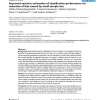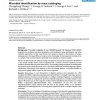889 search results - page 147 / 178 » General Conclusions |
104
click to vote
BMCBI
2006
14 years 12 months ago
2006
Background: Supervised learning for classification of cancer employs a set of design examples to learn how to discriminate between tumors. In practice it is crucial to confirm tha...
BMCBI
2006
14 years 12 months ago
2006
Background: The public availability of over 180,000 bacterial 16S ribosomal RNA (rRNA) sequences has facilitated microbial identification and classification using hybridization an...
BMCBI
2006
14 years 12 months ago
2006
Background: We present a novel strategy for classification of DNA molecules using measurements from an alpha-Hemolysin channel detector. The proposed approach provides excellent c...
116
click to vote
BMCBI
2006
14 years 12 months ago
2006
Background: Recent advances and automation in DNA sequencing technology has created a vast amount of DNA sequence data. This increasing growth of sequence data demands better and ...
BMCBI
2006
14 years 12 months ago
2006
Background: A key post genomics challenge is to identify how genes in an organism come together and perform physiological functions. An important first step in this direction is t...


